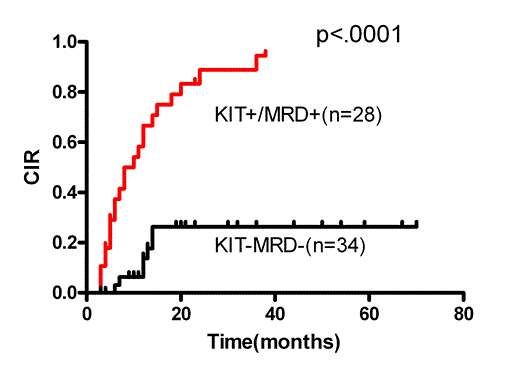Abstract
Although acute myeloid leukemia (AML) with t (8; 21) translocation generally belongs to the favorable-risk AML subtypes, relapse occurs in about 40% of cases and long-term (>5years) survival less than 50%. KIT-mutation (KIT+) and minimal residual disease (MRD) levels have been demonstrated as two most important risk factors in several retrospective studies. Until now, only two prospective studies (Our AML05 trial; French CBF-2006 trial) have assessed their respective prognostic values (Zhu HH, et al. Blood 2013; 121:4056; Jourdan E, et al. Blood 2013; 121:2213). We found both KIT+ and MRD were independent risk factors for relapse, but Joundan et al found only MRD rather than KIT+ was sole prognostic factor for relapse in multivariate anaysis. Both studies did not perform a comprehensive subgroup analysis combining the two factors, and risk-adopt postremission treatment might also affect this assessment. Therefore, we performed a subgroup analysis combining KIT mutation and MRD in a prospective protocol AML05 to answer which is more important to predict outcomes of t(8;21)AML.
From July, 2005, to Jan, 2013, 114 patients with t (8; 21) AML after achieving complete remission were included in this analysis. KIT mutations in exons 17 and 8 were screened using the direct sequencing method. MRD was detected using quantitative PCR to detect the RUNX1/RUNX1T1 transcript. MRD-positive (MRD+) was defined as < 3 log reduction of RUNX1/RUNX1T1 transcript from baseline after second consolidation therapy. Sixty-two patients received high-dose cytarabine-based consolidation chemotherapy (CT) or autologous hematopoietic stem-cell transplantation (auto-HSCT), and 52 patients received allogeneic HSCT (allo-HSCT).
When receiving CT/auto-HSCT as postremission treatment, KIT+ patients (n=19) had a higher 3 year cumulative incidence of relapse (CIR) than KIT-patients (n=43) (94.4% vs. 38.2%, p<0.0001). Similar results also found in MRD+ (n=19) and MRD- (n=43) patients (CIR 92.9% vs. 46.6%, p<0.0001). Among KIT+ patients, a very high relapse rate was found in both MRD+ and MRD-patients (CIR, 100% vs.88.9%). However, among KIT-patients, MRD+ patients had a significant higher relapse rate than MRD-patients (CIR, 84.4% vs.26.3%, p=0.0006). When pooling KIT+ and or MRD+ into one group (KIT+/MRD+), this group had a significant higher relapse rate than KIT-MRD- group ( 94.4% vs. 26.3%, p<0.0001), However, the prognostic values of KIT and MRD was lost when patients received allo-HSCT (CIR of KIT+/MRD+ and KIT-MRD-, 23.8% vs. 15.6%, p=0.47). Similar results were also been found in disease-free survival (DFS) and overall-survival (OS). Multivariate analysis revealed that KIT+, MRD+, and treatment (allo-HSCT or CT/auto-HSCT) were three independent prognostic factors for relapse (all p<0.0001), DFS (all p<0.0001) and OS (p<0.0001, p<0.0001, p=0.007).
Both KIT status and MRD level were important to predict relapse of t (8;21) AML. KIT+ patients hold a very high relapse risk.


The cumulative incidence of relapse (CIR) between KIT+/MRD+ group and KIT-MRD- group when receiving chemotherapy/auto-HSCT(A) and allo-HSCT(B) as postremission treatments in t(8;21) AML patients.
The cumulative incidence of relapse (CIR) between KIT+/MRD+ group and KIT-MRD- group when receiving chemotherapy/auto-HSCT(A) and allo-HSCT(B) as postremission treatments in t(8;21) AML patients.
No relevant conflicts of interest to declare.
Author notes
Asterisk with author names denotes non-ASH members.


This feature is available to Subscribers Only
Sign In or Create an Account Close Modal